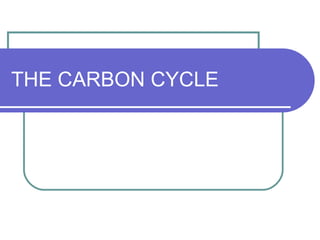Melden
Teilen

Empfohlen
Empfohlen
Weitere ähnliche Inhalte
Was ist angesagt?
Was ist angesagt? (20)
Carbon Cycle Lesson PowerPoint, Biogeochemical Cycles

Carbon Cycle Lesson PowerPoint, Biogeochemical Cycles
Andere mochten auch
Andere mochten auch (6)
Hepatoprotective wrightia tinctoria against ccl4 induced toxicity

Hepatoprotective wrightia tinctoria against ccl4 induced toxicity
Ähnlich wie Carbon cycle
Ähnlich wie Carbon cycle (20)
Carbon cycle
- 2. What Is Carbon? An element The basis of life of earth Found in rocks, oceans, atmosphere
- 3. Carbon Cycle The same carbon atoms are used repeatedly on earth. They cycle between the earth and the atmosphere.
- 4. Plants Use Carbon Dioxide Plants pull carbon dioxide from the atmosphere and use it to make food –— photosynthesis. The carbon becomes part of the plant (stored food).
- 5. Animals Eat Plants When organisms eat plants, they take in the carbon and some of it becomes part of their own bodies.
- 6. Plants and Animal Die When plants and animals die, most of their bodies are decomposed and carbon atoms are returned to the atmosphere. Some are not decomposed fully and end up in deposits underground (oil, coal, etc.).
- 7. Carbon Slowly Returns to Atmosphere Carbon in rocks and underground deposits is released very slowly into the atmosphere. This process takes many years.
- 8. Cycle – Repeats Over and Over and Over and Over …
- 9. Carbon Cycle Diagram Carbon in Atmosphere Plants use carbon to make food Animals eat plants and take in carbon Plants and animals die Decomposers break down dead things, releasing carbon to atmosphere and soil Bodies not decomposed — after many years, become part of oil or coal deposits Fossil fuels are burned; carbon is returned to atmosphere Carbon slowly released from these substances returns to atmosphere
- 10. Carbon in Oceans Additional carbon is stored in the ocean. Many animals pull carbon from water to use in shells, etc. Animals die and carbon substances are deposited at the bottom of the ocean. Oceans contain earth’s largest store of carbon.
- 11. The Carbon Cycle
- 12. Human Impact Fossil fuels release carbon stores very slowly Burning anything releases more carbon into atmosphere — especially fossil fuels Increased carbon dioxide in atmosphere increases global warming Fewer plants mean less CO2 removed from atmosphere
- 13. What We Need to Do Burn less, especially fossil fuels Promote plant life, especially trees